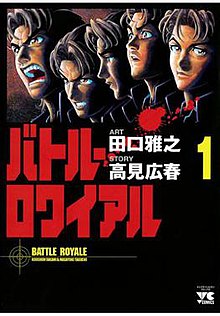Battle Royale (manga)
| Battle Royale | |

Cover of the first manga volume
|
|
|
バトル・ロワイアル (Batoru rowaiaru) |
|
|---|---|
| Manga | |
| Written by | Koushun Takami |
| Illustrated by | Masayuki Taguchi |
| Published by | Akita Shoten |
| English publisher | |
| Demographic | Seinen |
| Magazine | Young Champion |
| Original run | 2000 – 2005 |
| Volumes | 15 |
| Manga | |
| Battle Royale II: Blitz Royale | |
| Written by | Hitoshi Tomizawa |
| Published by | Akita Shoten |
| Original run | December 21, 2003 – May 27, 2004 |
| Volumes | 2 |
Battle Royale (Japanese: バトル・ロワイアル Hepburn: Batoru Rowaiaru?) is a Japanese manga series written by Koushun Takami and illustrated by Masayuki Taguchi. It is based on Takami's novel of the same name, telling the story of a class of junior high school children who are forced to fight each other to the death. It was serialized by Akita Shoten in Young Champion from 2000 to 2005, and later combined into 15 volumes, which were released in English by Tokyopop from 2003 to 2006. In October 2007, a special edition of the manga began being released.
The manga follows the plot of the novel fairly closely, but expands on the backstory of each of the students. It is far more sexually graphic than the novel and film versions, but like them, is noted for its intense, gory violence.
The English adaptation of the manga makes several changes to the plot, such as claiming that "[The] Program" is a reality TV show and changing the time setting of the story by almost 10 years; both changes are contradicted in later volumes.
At first the creators of the original version of the "Battle Royale" manga kept the story close to the original Japanese novel. As publication increased, Taguchi took increasing liberties with the story. Takami said that he looked forward to new installments of Taguchi's story and Taguchi said that he more strongly cared about the characters. Takami liked how Taguchi distributed the time among characters; Takami said that in the manga the characters changed and grew as the story progressed, unlike in the original novel. Taguchi said that in the manga version he modeled most of Takami's characters after people he personally knew. Takami describes Taguchi's stance as closer to his own than the stance of Kinji Fukasaku, the director of the film. Takami describes the manga as containing the feeling of "a general, nonjudgmental love for humans."
...
Wikipedia
